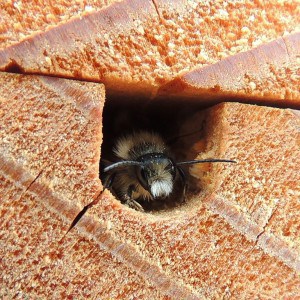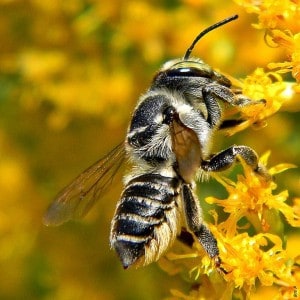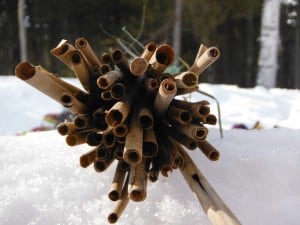In my last column, I began a discussion about the importance of our native bee species. It is becoming increasingly clear that native wild bees – not just Honey Bees – are vitally important pollinators for our food system and ecosystem health in general. The bad news, however, is that bees are under siege from many quarters. This week, I’d like to take a closer look at the life cycle of these fascinating insects, the threats they face and how landowners and gardeners can provide help.
Life cycle
Almost three-quarters of wild bees (most species of the Halictidae, Apidae and Colletidae families) nest in the ground. Nests are typically located in well-drained areas with minimum plant cover and a southern exposure. Look for a straw-sized hole with a “slag” heap of excavated soil around the perimeter. Andrenidae (miner bees) and Megachilidae (leafcutter, orchard and mason bees), on the other hand, are cavity nesters and often lay their eggs in the hollow part of a stem or in a hole excavated in wood.
To understand a typical native bee’s life cycle, let’s take the example of the squash bee, a ground nester. Adults first appear in July, having over-wintered as pupae. When squash and related plants flower and pollen and nectar are available, the female excavates a nest 12 to 22 centimetres below the surface of the soil. She will make five cells, depositing an egg and a pollen ball in each cell. When the eggs hatch, the larvae eat the pollen and eventually pupate. Development stops at this point and the baby bee will remain in the pupal or “resting” stage until the following July, when it emerges as an adult. Females may construct more than one nest in a season. Males live outside of the nest and have nothing to do with domestic duties.
Bumble bees are a notable exception to the typical native bee life cycle. Their behaviour resembles that of Honey Bees. Unlike the latter, however, the only bumble bee to survive the winter is the queen. She enters hibernation -or diapause as it is called in insects – already mated. When she emerges in the spring, she begins foraging for pollen and nectar and, depending on the species, makes a nest in the ground or in some kind of cavity. Typical nesting sites include rodents’ holes, rock piles and cavities in a tree or wall. For the first few weeks, the queen will raise only worker bumble bees, who are much smaller in size. Later in the season, however, the queen will stay in the nest and become solely an egg-layer. In the fall, she will begin to produce males and a generation of new queens. The job of the males is to mate with the queens – preferably from another population. The old queen will then die, as will the workers and the males. The only bees that will survive the winter are the young, mated queens. Because bumble bee colonies only survive one season, they are much smaller than Honey Bee colonies.
Decline
Despite the 400 or so species of native bees in Ontario, there have been serious declines in many populations. For example, the once-common Rusty-patched Bumble Bee is now on the provincial Species at Risk list with a designation of Endangered. As you might expect, human activity is the main reason for these declines. The negative impacts often come as a side effect of modern management practices on farms, in greenhouses, along road allowances and even in our gardens. Among the practices that reduce food sources for bees are the cutting of hay fields at first bloom (to achieve maximum nutritional quality in the hay), the removal of hedgerows (to facilitate the use of large machinery on fields), the elimination of weeds from roadsides and field margins (many weeds are great sources of nectar and pollen) and the use of new flower varieties in gardens (often bred not to produce pollen and/or nectar). Nesting sites, too, are often destroyed or made inaccessible as a result of cutting back raspberry canes, using mulch in gardens, removing dead trees and, once again, eliminating hedgerows. It is also thought that bees that are managed for pollination on a large scale (like bumble bees in a greenhouse) are having a large impact. This happens when disease-carrying individuals escape into the wild and spread the disease to wild bee populations.
As has been widely publicized, a more direct cause of population decline is the use of pesticides. They may kill adult bees directly, affect their behaviour and efficiency as foragers of pollen and nectar, affect the development of brood that is feeding on pesticide-tainted pollen and/or weaken the bees and make them more vulnerable to disease. Neonicotinoids (neonics), a neurotoxin, appear to be especially dangerous. New research from the University of Guelph and Imperial College shows that neonics harm bumblebees by impairing their ability to learn how to collect pollen. Bumble bees probably even suffer more damage than Honey Bees from exposure to these pesticides, since their colonies are so much smaller. Neonicotinoid pesticides are commonly coated on agricultural seeds for crops such as corn and canola to protect the plants from insect pests such as aphids. Fortunately, Ontario plans to eliminate the widespread, indiscriminate use of neonicotinoid-based pesticides and move to a permit-based system. A study by Friends of the Earth also found the pesticide in more than half of the garden plants tested at Home Depot outlets across Canada. Home Depot has now announced that it plans to begin labelling all plants that contain neonics.
Wild bee conservation
If you are a landowner, you can do a lot to protect wild pollinators such as bees. The size of your land matters little, since many species will even thrive in small urban spaces if encouraged to do so. Here are a few suggestions for getting started.
• Stop using pesticides. In addition to neonics, the insecticide Furadan is extremely toxic to bees. For more information on pesticide toxicity, visit the OMAFRA website.
• Take time to become aware of wild bees already foraging and/or nesting on your property. If they have pollen balls on their hind legs or are covered in pollen, they are bees! Remember, though, that native bees can come in all sizes, colours and shapes.
• Leave any hedgerows or other natural areas on your property undisturbed.
• Plant mostly native flowers, shrubs and trees. Some of the best choices include wild apple (Malus pumila), willows, chokecherry, staghorn sumac, raspberry, Joe-pye weed, goldenrods, asters, evening primrose, common sunflower (Helianthus annus), purple coneflower, pumpkin/squash, lamb’s ears and comfrey. Soil-improving crops, too, like clovers, alfalfa and buckwheat provide a veritable feast of nectar and pollen. Make sure the plants you buy are pesticide-free such as those sold by GreenUp Ecology Park in Peterborough.
• Establish and protect suitable nesting sites. Reserve some south-facing slopes and field margins for this purpose. Keep any grass cover cut short. Some species will also nest in sandy areas, including abandoned sandboxes. If you grow raspberries, don’t destroy the old stems, but keep them in vertical bundles in the garden for at least a year. Not only will yellow-faced and leafcutter bees use them for nesting, but you will have a stable population of pollinators. You can also make artificial nests for stem-dwelling bees, including mason and leaf-cutters, by bundling together the hollow stems of Phragmites (also called Common Reed – found along roadsides). Cut 20 stems to a variety of different lengths of about six to eight inches, bundle them together with string and place them in a plastic pail or similar container lying on its side. This provides protection from the elements. Attach the pail to a branch or post, so that the stems face east or southeast. For more detailed instructions, click here to see a great video at by Susan Chan of Farms at Work. Xerces.org also provides information on building a variety of native bee nesting structures.
You can also purchase commercially-made bee nesting tubes from websites such as www.crownbees.com Their BeeEndeavour Kit has been recommended to me. This website is an excellent resource for native bee information in general and has a great newsletter. I also recommend picking up a copy of A Landowner’s Guide to Conserving Native Pollinators in Ontario by Susan Chan. It is available at the Avant-Garden Shop or by contacting Chan herself at sue@farmsatwork.ca Avant-Garden also carries bee nesting structures.


